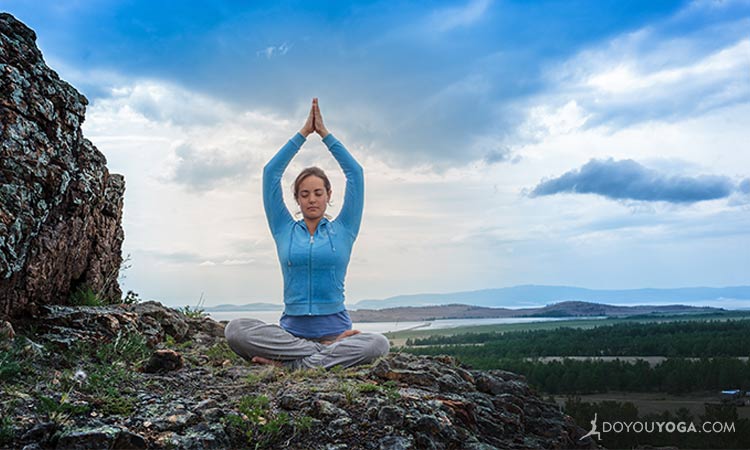As we cultivate a deeper understanding of yoga, let’s revisit some of its fundamental concepts.
Jnana or correct knowledge explains that we not only have to have book-smarts, but self-awareness too. Jnana includes awareness, wisdom, understanding, self-inquiry, consciousness, and balance.
The yogis say that we can find everything we need within ourselves. Whew! No need for that expensive college degree or quest halfway across the world for an ancient Indian Guru!
No, not really. In order to tap into this all-encompassing well of self-awareness, we have to understand ourselves deeply, and we have to practice and apply this knowledge as much as we can.
The External World and You
While maya or the external world pulls at our attention, keeping us busy looking for purpose and meaning on the outside, this usually leaves us confused, frustrated, and looking for more.
By practicing the attitude of jnana, we can stay grounded within ourselves regardless of our circumstances.
To better understand the relationship between maya (world-stuff) and internal fulfillment, read and study my previous article, “Are You a Prisoner?”
Recognize that everything you have ever needed and ever will need can be found within yourself, in this present moment. Once the temptation of maya is eliminated, the attention can be turned to the self.
Building Wisdom of the Body
Jnana refers to the wisdom of the body.
Instead of simply following a yoga teacher’s instructions, be sensitive to your own experience in the poses. Be aware of the tensions in your body. This awareness sends a signal to the nervous system and tells it to let go of old tension patterns.
If your yoga class does not allow for variations in its postures or the ability to “flow on your own,” perhaps find a class that does. Another challenge is to practice without a mirror, or position yourself in the room so that you do not depend on the mirror.
Better yet, practice with your eyes closed or with a blindfold! Your attention will automatically turn inward.
The freedom to move faster or slower, to add in or take out a posture, and to practice without the use of your eyes should be your choice, depending on what your body needs. And if you listen to your body, it will tell you what it needs.
Doing What Feels Right for You
If you pay attention to your body and do what feels right for you, your body will respond and heal itself. With this level of awareness, you will be able to detect imbalance or disease in the body before it escalates into something worse. Take the following examples.
- Sore throat– This can be a reminder to drink more water, get more rest, reduce sugar intake, and limit other immune-suppressing actions.
- Low back pain – This can be a sign to correct your posture while seated at your desk, improve core strength, or avoid lifting heavy objects.
- Jaw tension – This can produce headaches, teeth grinding, and anxiety, forcing you to take note of external stressors that are causing you to clench your teeth.
- A negative mood – This can cause impulsive behaviors like spending and eating. Remembering to turn that frown upside down improves dietary discipline and fosters healthy relationships with those around you.
- Persistent pain in a joint – This can alert you to and underlying condition, prompting you to seek medical care. And the sooner a problem is recognized, the less likely it is to progress to something more serious or chronic.
Asanas to Cultivate Jnana
Jnana is acquired through concentration, coordination, sense training, breath awareness and control, and balance. This attitude corresponds to poses involving upward and sideward stretches, extremities, and pranayama or breath control.
Through these poses, we develop body consciousness, starting with awareness of the muscles, breath, and internal organs.
We can then advance to awareness of shifting energy within the body in the form of the chakras or energy centers, and nadis or channels of energy and consciousness.
Try the following poses to cultivate an attitude of jnana.
1. Butterfly Pose
 Credit: Lacey Haynes
Credit: Lacey HaynesSit with your knees bent, soles of the feet touching, spine straight. Grab ahold of your feet with your thumbs pressing into the arches, and press the knees towards the floor with your forearms.
Inhale as you lift and lengthen the spine, and exhale to relax into the inner-thigh stretch. Pull your abdominals in and shoulders down and back. Hold for 10-15 breaths.
2. Tree Pose

Inhale to lift one leg, placing the sole of the foot firmly into the opposite lower leg, inner thigh, or folded into the thigh crease (depending on your level of comfort and flexibility). Create equal pressure between the right and left legs and feet to find stability and balance.
Fix your drishti or gaze on a point a few feet in front of you and come to your breath. Inhale to find your arm position, either overhead in a “V,” behind your low back in reverse prayer, or in namaskar or prayer postion at the heart center. Hold for 5-10 breaths. Change sides.
3. Triangle Pose
 Image Credit: Julia Lee
Image Credit: Julia LeeStand with your feet apart wider than hip distance, the front foot pointing forwards and the back foot at a 30-degree angle.
Inhale the arms wide apart, hinge forward from the waist over the front foot, and reach down to place the hand to the shin of the same leg. The opposite arm reaches to the sky, and your gaze follows.
Position your hips and shoulders in alignment, putting equal pressure through both feet. Reach your head towards the front of the room to avoid sinking into the front hand.
Imagine that you are placing your body between two panes of glass. Hold for 5-10 breaths. Inhale to stand tall, and change sides.
Om Shanti.


